New Chromatography Columns and Accessories at the 2006 Pittcon Conference: Part I
LCGC North America
This month's installment of "Column Watch" is the first of a two-part series in which Ron Majors examines the trends and highlights in columns and consumables at Pittcon 2006.
Pittcon 2006 — the 57th Pittsburgh Conference on Analytical Chemistry and Applied Spectroscopy — will return to the Orange County Convention Center in Orlando, Florida on March 12–17, 2006. This year's event will host more than 1000 instrument manufacturers and laboratory suppliers in more than 2300 booths. In addition to attending the exposition, the conferees will have the opportunity to listen to more than 2200 oral and poster presentations, which will include invited and award symposia, check out 50 seminar rooms, or attend one of 100 short courses.

Undoubtedly, Pittcon still remains the most important yearly international analytical exhibition where companies introduce their latest instruments, instrument accessories, columns, sample preparation products, and other consumable products. Because many past attendees have purchased one or more new products within three months after attending the show, most exhibitors attempt to maximize their booth traffic to meet as many potential customers as possible.
The purpose of this report is to provide information about many of the new separation consumables and accessory products that will be displayed at Pittcon 2006. In some cases, products that were introduced during 2005 but after Pittcon 2005 (1,2) have been be included for reasons of completeness. The information is based upon manufacturers' responses to a questionnaire mailed in December 2005. Because of space limitations and the fact that some manufacturers did not respond to the questionnaire, this report cannot be considered an exhaustive listing of all new products that will be introduced in Orlando. However, over the years, these Pittcon introduction summaries have provided a good source of information that would be difficult for one individual to gather during the four days of the exhibition. In addition, the products introduced have shown definite correlations to current research, development, and application activity in the separation sciences.

Companies Listed in This Column
As in previous years, columns and other products recommended by their manufacturers primarily for biomolecule separations or sample preparation are denoted in the tables with the designation BIO. Some of these products can be used for general high performance liquid chromatography (HPLC) separations as well, but their main emphasis is for biological samples. I will cite specific information about bioapplications where appropriate. Because HPLC columns for microbore (1.0–2.1 mm i.d.) and high-throughput HPLC (lengths less than 50 mm) are now numerous, they will be covered in the individual modes.
In this month's coverage, I describe new introductions in the areas of high performance liquid, reversed-phase, normal- and bonded-phase, ion-exchange and ion, size-exclusion (SEC), large- and preparative-scale, and specialty chromatography columns. Next month, I will look at gas chromatography (GC) columns, sample preparation products, and hardware, accessories and kits for chromatography and sample preparation.
Trends and Highlights
General: This year, I observed that there was a continued trend in miniaturization of the chromatographic experiment, not only with the preparation of smaller samples in the microliter-to-submicroliter range but also in the dimensions of the columns, especially in the increasing use of short, sub-2-μm dp columns in HPLC and LC–mass spectrometry (MS). Still, a large number of products will be introduced for the separation, sample preparation and for LC–MS measurement of biomolecules, still the hottest area in chromatographic research and applications. New breeds of low-bleed phases and ultra inert surfaces for both GC and LC–MS were noted. Monolith technology continues to see new entries of both polymeric- and silica-based stationary phases.
HPLC columns: Reversed-phase HPLC maintains its dominance and a significant number of regular and specialty reversed-phase columns will be introduced. Particles and column internal diameter (i.d.) are getting smaller and columns are getting shorter with sub-2-μm particles now being offered by several companies; the smallest particle had a diameter of 1 μm. No irregularly shaped silica gel packed columns in analytical sizes will be introduced this year; spherical packings now dominate. Flash chromatography, preparative and process columns, and the availability of bulk packings for self-packing of these columns seem to have had a renaissance, undoubtedly driven by the need to purify new drug candidates and biomolecules. Specialty columns will be numerous with one-third of them recommended for protein–peptide separations and one-third for chiral separations. Columns for hydrophilic interaction chromatography (HILIC) are to be introduced. Carbon nanotube separation columns will be introduced by two companies, one by SEC and one using ion exchange.
Gas chromatography: GC columns this year will be highlighted with more introductions of lower bleed phases and ultra inert phases that provide enhanced sensitivity, lower baseline drift during temperature programming and improved MS capability. Some have higher temperature limits. A extremely polar phase with 90% biscyanopropyl functionality will be introduced as a truly orthogonal phase for 2-D GC. As usual, several application-specific columns will be introduced, especially for use in the separation of environmental compounds such as pesticides and polychlorinated biphenyls. In addition, columns for cis-trans fatty acids and enantiomers are noted. Only one porous layer open tubular (PLOT) column for oxygenate analysis will be introduced; the rest are wall coated open tubular (WCOT) columns.
Sample preparation: Products for the preparation of tiny amounts of samples in the microliter and submicroliter range will be quite prevalent. Formats range from customizable 96-well solid-phase extraction (SPE) plates and plates with bonded phase surfaces to SPE pipette tips. Many polymeric SPE packings and the first molecular-imprinted polymer standard product for chloramphenicol will be introduced this year. Products for the removal of high abundance proteins from serum, mostly based upon affinity resins will be a particularly hot area.
Accessories: I noted 31 new accessories for LC, GC, capillary electrophoresis (CE) and capillary electrochromatography (CEC), and sample preparation. Introductions of new general-purpose laboratory products like vials, caps, fittings, and ferrules will be very prominent this year. In GC, new designs of inlet liners and unions, a variable flow splitter, and space saving gas generators are noteworthy. A portable hydrogen storage unit should be popular for GC field testing. For LC, column-switching kits and miniaturized and high-pressure hardware systems with low dead volume, and an in-line mobile phase heater–cooler should help high-temperature HPLC performance.
New Series of HPLC Columns and Packings
Each year manufacturers introduce entire new families of HPLC columns at Pittcon. For the sake of brevity, I have elected to cover those series here instead of listing each column under individual headings in the modes' tables. Table I covers those new families of HPLC columns and packings displayed at Pittcon 2006. In some cases, the series are major extensions of existing products in the companies' offerings but covering an entire mode or group of phases while in other cases the series are entirely new to the market.
The highlight of new families of products was the introduction of sub-2 μm packings and columns by five companies. Small particles packed into short columns give high throughput separations without loss of resolution or when packed into long columns give high resolution separation of more complex mixtures, albeit at the higher operating pressure. Agilent Technologies (Santa Clara, California), Grace-Alltech (Deerfield, Illinois), Sepax Technologies (Newark, Delaware), ThermoElectron (Bellefonte, Pennsylvania), and Waters (Milford, Massachusetts) all had small particle columns. These small particles were packed into columns as short as 20 mm and as long as 150 mm and internal diameters as small as 0.075 mm and as large as 4.6 mm. In these small particle columns, a wider variety of stationary phases are available this year compared to Pittcon 2005 (1).
Flash chromatography packings and columns were also introduced. Flash chromatography has been made more convenient by the introduction of prepacked columns and dedicated instruments. Formerly, chemists would pack their own glass columns with large particle silica gel or soft organic gels and by using gravity-fed systems collect fractions from synthesized crude organic or protein mixtures. Now, there almost as many flash chromatography phases available as there are HPLC stationary phases. For those preparing large axial-compression preparative columns, bulk materials can be purchased and packed or repacked as needed.
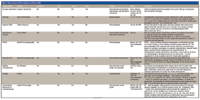
Table I: New series of HPLC columns at Pittcon 2006
The POPLC system was introduced by Bischoff Chromatography (Leonberg, Germany). This is an optimized set of columns with different complementary stationary phases that is used for method development by isocratic mobile phase scouting rather than by using gradient elution. Their hardware configurations allow them to quickly connect columns in series for mixed separation modes.

Table II: Reversed-phase chromatography columns at Pittcon 2006
Reversed-Phase Chromatography
As usual, many new reversed-phase columns will be introduced at Pittcon 2006 (see Table II). If one also adds all the reversed-phase columns covered in the new series (Table I), in specialty columns (Table III) and in the preparative chromatography section, one can clearly see the dominance of this operational mode. Silica-based bonded phase columns will dominate the introductions again this year but a few hybrid, zirconia and polymeric columns also will be on the scene.

Table III: HPLC Specialty Columns at Pittcon 2006
The most popular reversed-phase bonded phase always has been C18 (octadecylsilane) and this year proved it to be true once again with 18 C18 columns being introduced in all categories. However, this phase is not always the optimum for all separations and C8, polar-embedded C18, and cyanopropyl phases will be made available to present different selectivity alternatives. In general, C8 has similar selectivity to the C18 phase but somewhat lower retention at the same mobile phase composition. The polar-embedded phases are particularly suited for the separation of basic compounds. These phases are useful for the separation of polar compounds where a low percentage of organic modifier is required and where phase collapse (dewetting) can be a problem. The CN phases offer a short-chain reversed-phase packing that has some polar character by virtue of the cyano functionality. Besides lower retention, selectivity can be quite different when compared with C8 and C18 phases. The cyano column can also be used for normal-phase chromatographic separations by careful changeover from the aqueous-based mobile phase to entirely organic mobile phase.

Over the past several years, a number of longer-chain alkyl phases as large as C30 have been introduced. These long-chain phases provide a greater degree of shape selectivity than a typical C18 phase, have long proven superior for the separation of cis-trans carotenoid isomers, are resistant to phase collapse at low percentage of organic solvent in the mobile phase and have high loadability. This year another C30 phase joins the ranks.
Most chromatographers facing a separation problem almost immediately go to a C18 stationary phase. Sometimes, though, it might be necessary to go beyond the standard column to achieve better selectivity. Figure 1 shows an example of the separation of corticosteroids on a C18 phase, a phenyl phase, and a new biphenyl phase from Restek (Bellefonte, Pennsylvania). The biphenyl functionality appears to offer a slightly different selectivity than the C18 and a quite different selectivity to the phenyl. The Allure Biphenyl phase appears to provide a unique π–π selectivity for unsaturated compounds. For the corticosteroids, the column did offer a better separation under the reversed-phase conditions employed. Although the structures are not shown, these compounds are very similar and were separated in a simple isocratic analysis.
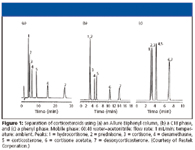
Figure 1
Temperature has gotten recent attention as a chromatographic variable in method development. When the temperature is increased, solvent viscosity is decreased resulting in a lower column back pressure, solute retention is reduced, and column efficiency is improved. On the downside, higher temperatures can affect solute stability, a fear of some researchers. In addition, many, but not all, silica-based packings and phases have life problems, especially at higher pH values. Polymeric and other high-temperature-stable columns have efficiency or surface chemistry problems and most HPLC column ovens–heaters have not had very high temperature capability. The situation has changed with the introduction of temperature-stable columns and new oven configurations capable of high temperature operation. Restek (Bellefonte, Pennsylvania) has come up with a high temperature reversed-phase material that will withstand temperatures as high as 200 °C over a wide pH range.
Ion-Exchange Chromatography–Ion Chromatography
Besides ion-exchange specialty columns in Tables I and III, Dionex (Sunnyvale, California) and Sepax Technologies will introduce new ion-exchange columns. The Dionex IonPac stationary phases are prepared using a unique polymer bonding technology. In their preparation, a novel hyperbranched anion-exchange polymer is electrostatically attached to a surface-sulfonated wide-pore polymeric substrate. This new polymer bonding technology allows control the column selectivity and capacity through alternating treatments of epoxy monomer and amine. Both columns are anion exchangers with alkanol quaternary ammonium functionality and ion-exchange capacities of 210 μ equiv (AS-22) and 315 μ equiv (AS-23). Both 2-mm and 4-mm i.d. columns were included as well as matching guard columns. The columns are suited for the separation of common inorganic anions in drinking water and other matrices according to EPA Method 300.0 using simple carbonate–bicarbonate buffers and suppressed conductivity detection. The carbonate peak is well resolved from the other ions. The AS-23 column is further recommended for those samples also containing oxyhalides such as chlorite, bromate, and chlorate according to EPA Method 300.1. The columns have pH stabilities over the entire pH range and therefore are suitable for very caustic and acidic samples.
The Sepax Proteomix ion-exchange offerings are based upon very highly crosslinked (80%) nonporous polystyrene–divinylbenzene (PS-DVB) spherical resins with particle diameters of 1.0, 1.7, and 3-μm. The smaller sizes are recommended for the ultrahigh-pressure and high-speed LC of proteins, peptides, nucleic acids, and carbohydrates. Four chemistries, two cation exchangers (sulfonic strong cation and carboxyl weak cation), and two anion exchangers (quaternary ammonium strong anion and diethylamine weak anion) are available. The columns will be available with nano- (50–75-μm), capillary (0.15–0.75 mm), microbore (1.0–2.1 mm), and conventional (4.6 mm) internal diameters and 3–10 mm lengths with stainless steel or PEEK construction. The proprietary surface chemistry on the nonporous resins enables separation capacity comparable to that of porous resins.
Normal-Phase–Adsorption Chromatography
In addition to bare silica gel columns introduced in Table I, there will be one notable introduction by J.T. Baker/Mallinkrodt, the company's BakerBond Spherical Flash silica. Sold in bulk and in prepacked cartridges, the spherical packing material should pack more reproducibly and provide higher mechanical strength and fewer fines, thereby allowing higher flow rates at lower back pressure than the more typical irregular silica gel materials. The silica gel has a 50-μm particle size and 60-Å pores.
Size Exclusion Chromatography
Each year only a few new SEC columns are introduced at Pittcon. This year, a total of six phases will be introduced, four by Sepax Technologies (Newark, Delaware) and two by Polymer Laboratories (Amherst, Massachusetts), now part of Varian (Palo Alto, California). The Sepax offerings, called the CNT line, are really specialty columns for the SEC separation of carbon nanotubes, nanoparticles, and nanorods based upon their lengths. The recovery for the length-dependent separation of DNA-wrapped carbon nanotubes is nearly 100%. The columns are packed with spherical silica particles of 5-, 7-, or 10-μm diameter with pore sizes of 300, 500, 1000, and 2000 î The particles have a proprietary bonded stationary phase. Stainless steel columns are available in a variety of internal diameters of 4.6–21.2 mm. Another carbon nanotube separation column based upon ion-exchange properties (rather than SEC) can be found in the Specialty columns section (Table III).
Polymer Labs will introduce one nonaqueous PS-DVB PLgel SEC column that is devoted exclusively to the separation of polyolefins in trichlorobenzene. The 13-μm material is suited for polymers as large as 109 g/mol. The 300 mm X 7.5 mm column is designed to provide improved resolution and an increased operating range over previously offered columns of this type. A guard column packed with the same material is also provided.
Polymer Labs second offering is a proprietary macroporous polyhydroxyl column for use in aqueous SEC. The column's 5-μm particles, small for a typical SEC column, equate to a higher resolution of lower molecular weight water-soluble polymers as large as 20,000 g/mol. The column also has the 300 mm X 7.5 mm dimensions.
Specialty HPLC Columns
Specialty columns are HPLC columns that have been developed for specific separations that are difficult to achieve on a standard column. However, sometimes manufacturers will use a standard column but test it specifically for a certain class or compounds and provide a recommended set of chromatographic conditions. In some cases, the specialty column comes as part of a "total solution" kit with reagents, standards, and method. Most specialty columns are delivered with a test chromatogram from an analysis performed at the factory before shipment, and some are guaranteed. Table III shows the 26 specialty columns that will be presented at Pittcon 2006. Silica gel–based columns will dominate, but polymer-based, hybrid, and zirconia specialty columns also will be introduced.
The largest categories of specialty columns are those designated for the separation of biomolecules (one-third of total), mainly proteins and peptides, and those for the separations of chiral compounds (one-third of total).
A variety of selective columns for protein analysis and purification using principles such as affinity and immobilized metal ion affinity chromatography (IMAC) will be introduced at Pittcon 2006. Some representative examples include columns introduced by Dionex Corp (Sunnyvale, California), who displayed an IMAC column specific for His-tagged proteins and a second mixed mode monolith column that can be used at high flow rates with a low pressure drop, Orachrom's (Woburn, Massachusetts) simulated monolith gigaporous columns for protein purifications by affinity-derivatization and tagged proteins, and, and Agilent's mRP-C18 (Santa Clara, California) column for membrane and other sticky proteins. Waters' (Milford, Massachusetts) peptide mapping column is based upon their silica-hybrid particle BEH technology.
A larger than normal number of chiral columns are slated for introduction at Pittcon 2006. The regular chiral companies such as Chiral Technologies (West Chester, Pennsylvania) and Astec (Whippany, New Jersey) will be present but this year Zirchrom (Anoka, Minnesota) joined their ranks with zirconia-based chiral columns. Zirchrom uses the strong Lewis acid sites on the zirconia base material to their advantage by using that group to anchor the chiral selector. Interestingly, the chiral phase can be removed by alkaline treatment to regenerate a contaminated or spent column or to convert the column into another chiral phase by rinsing with a chiral selector solution. Chiral Technologies has expanded their popular Chiralpak phases to include capillary dimensions. Because supercritical fluid chromatography (SFC) is a popular technique for chiral purifications, especially in the preparative mode, several of the chiral columns can be used for SFC separations in addition to HPLC separations.
To illustrate the advantages of a specialty chiral column, the right-hand chromatogram in Figure 2c shows the chiral separation of trans-stilbene oxide on a Cyclobond I 2000 DNP column. There was no separation on the Cyclobond I 2000 column, which is a β-cyclodextrin column. However, by the derivatization of the β-cyclodextrin to provide dinitrophenyl functionality bonded through an ether linkage (Figure 2a), the two enantiomers of trans-stilbene oxide were well resolved using an isocratic mobile phase system. With this derivatized phase, a π-sharing system is established with analytes have π-systems in the stereogenic environment. trans-Stilbene oxide with its aromatic rings satisfies this requirement. This phase demonstrates enhanced selectivity over the conventional β-cyclodextrin phase.
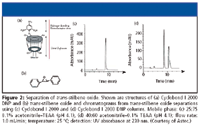
Figure 2
This year, a number of HILIC columns will be introduced. HILIC is a separation technique for highly polar analytes that get around some of the problems associated with reversed-phase chromatography such as low retention or phase collapse (dewetting). HILIC uses a polar stationary phase such as bare silica gel or polar bonded phase (for example, diol) and requires a high percentage of a nonpolar mobile phase, similar to the requirements for normal-phase chromatography. However, unlike normal-phase chromatography, which uses nonpolar solvents like hexane and methylene chloride and tries to exclude water from the mobile phase, HILIC requires some water in the mobile phase to maintain a stagnant enriched water layer on the packing surface into which analytes might selectively partition. In addition, water-miscible organic solvents are used. Under HILIC, polar analytes are well retained and are eluted in order of increasing hydrophilicity. ES Industries (West Berlin, New Jersey) and Angela Technologies (Newark, Delaware) plan to introduce columns for HILIC with amide and hydroxyl functionality. In a slight twist, MicroSolv Technology (Eatontown, New Jersey) will introduce the Cogent UDA column for a technique called "nonaqueous normal phase" where the packing is terminated with hydride group (Si-H) rather than silanols.
Specialty columns for explosives, LC–MS, carbon nanotubes (by virtue of their interaction with oligonucleotides on the DNA wrapping), oligonucleotides and halogenated compounds round out the offerings. The Dionex Acclaim Explosives column provides a baseline separation of the 14 explosive compounds outlined in EPA Method 8330 "Nitroaromatics and Nitramines by HPLC." The separation on the silica-based Acclaim column is shown in Figure 3. The method is useful for the separation of explosives in these explosive compounds in surface and ground water.

Figure 3
Preparative Chromatography
Four new column products and one column packing device, specifically for preparative chromatography were introduced at this year's Pittcon. Merck KGaA (Darmstadt, Germany) expanded their line of Chromolith silica monolithic columns to include a semipreparative reversed-phase version. Previously, the company introduced a capillary version (0.1-mm i.d.), in analytical version (4.6-mm i.d.) and preparative version (25-mm i.d.). The Chromolith Semi-Prep RP-18 has the dimensions of 10-mm i.d. by 100-mm length. For the best peak shape for basic analytes, the silica monolith is endcapped. The column is cladded with PEEK polymer. The monolith has a surface area of 300 m2 /g and 18% carbon coverage (3.6-μm/m2 ). Although the column pressure rating is 150 bar, due to its monolithic structure operating pressure is generally much lower. Figure 4 shows the scaleup of a pharmaceutical separation from a 4.6-mm i.d. analytical column to the 10-mm i.d. semipreparative column of the same length. The injection of 10 mg of each compound (30 mg total) is shown in the figure; up to 80 mg per compound has been reported for this semipreparative column in less than 30 min (3).
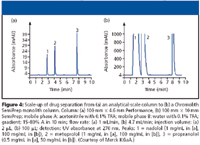
Figure 4
Waters (Milford, Massachusetts) has expanded the SunFire Prep column line and has added a silica gel column. In preparative LC, adsorption chromatography is a popular mode. The mobile phase solvents that are used are usually volatile and therefore more easily removed from collected fractions than when the compounds are separated by reversed-phase HPLC with aqueous solvents. The Waters column is based on high purity (Type B) silica of particle sizes of 5- and 10-μm. The pore size is 100 Å, ideal for small molecules. The columns are packed to their optimum bed density (OBD) and a scaleable such that separations achieved on other SunFire columns can be matched on the preparative version. Various dimensions are available.
Phenomenex (Torrance, California) added a SecurityGuard Prep guard column. Since samples injected into preparative columns often contain impurities and other compounds that may foul the expensive preparative column, a guard column is always advisable to protect the preparative column against contamination. Phenomenex's guard column is provided in a 21.2-mm i.d. X 15-mm length for all their common preparative phases available in 18–50-mm i.d.'s. The cartridge design makes it convenient to change guard columns.
Phenomenex also displayed the AXIA column packing and hardware system that uses a hydraulic piston to keep pressure on the packed bed. Often preparative columns operated continuously at high flow rate conditions can have fundamental problems such as collapse, voiding, and channeling of the packed bed resulting in variable or lower efficiency. With this computer-controlled new system, the bed density is custom calculated and adjusted for column size. With controlled hydraulic compression, the support media is never allowed to decompress resulting in overall column-to-column consistency.
Acknowledgment
I would like to thank the manufacturers and distributors that kindly furnished the requested information in advance of Pittcon 2006, thus, allowing a timely report on new product introductions. For those manufacturers who would like to be considered for inclusion into Pittcon 2007 coverage, please send the name of the primary company contact, the mailing address, FAX and e-mail numbers to Patrick Kempf, Managing Editor, LCGC North America, c/o Advanstar Communications, 485 Rte. 1 South, Bldg. F, Iselin, New Jersey 08830, Attn.: Pittcon '07 "ColumnWatch."
Ronald E. Majors "Column Watch" Editor Ronald E. Majors is business development manager, Consumables and Accessories Business Unit, Agilent Technologies, Wilmington, Delaware, and is a member of LCGC's editorial advisory board. Direct correspondence about this column to "Sample Prep Perspectives," LCGC, Woodbridge Corporate Plaza, 485 Route 1 South, Building F, First Floor, Iselin, NJ 08830, e-mail lcgcedit@lcgc-mag.com
References
(1) R.E. Majors, LCGC 23(3), 248–265 (2005).
(2) R.E. Majors, LCGC 23(4), 358–369 (2005).
(3) Speed and Performance in Monolithic Form: Chromolith HPLC Columns, Merck KGaA, Darmstadt, Germany, Publication W288101 (2005).
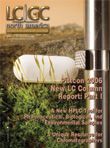
TD-GC–MS and IDMS Sample Prep for CRM to Quantify Decabromodiphenyl Ether in Polystyrene Matrix
April 26th 2024At issue in this study was the certified value of decabromodiphenyl ether (BDE 209) in a polystyrene matrix CRM relative to its regulated value in the EU Restriction of Hazardous Substances Directive.
LC–MS/MS-Based System Used to Profile Ceramide Reactions to Diseases
April 26th 2024Scientists from the University of Córdoba in Córdoba, Spain recently used liquid chromatography–tandem mass spectrometry (LC–MS/MS) to comprehensively profile human ceramides to determine their reactions to diseases.
High-Throughput 4D TIMS Method Accelerates Lipidomics Analysis
April 25th 2024Ultrahigh-pressure liquid chromatography coupled to high-resolution mass spectrometry (UHPLC-HRMS) had been previously proposed for untargeted lipidomics analysis, but this updated approach was reported by the authors to reduce run time to 4 min.